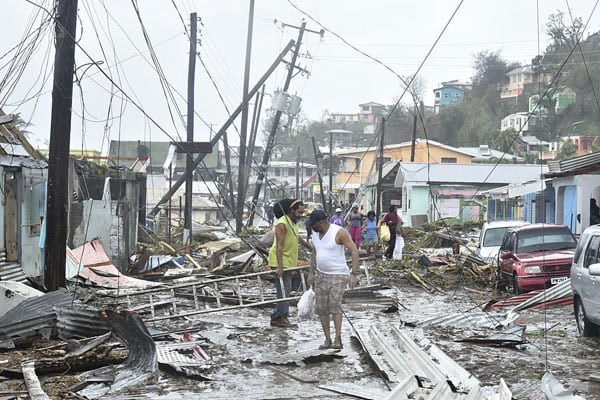
May 29, 2018; Washington Post, New York Times, and the New England Journal of Medicine
A new Harvard study published Tuesday in the New England Journal of Medicine estimates that at least 4,645 deaths can be linked to Hurricane Maria and its aftermath in Puerto Rico, “making the storm far deadlier than previously thought,” report Arelis B. Hernández and Laurie McGinley in the Washington Post.
Hurricane Maria, according to the US National Hurricane Center, is the third-costliest hurricane in US history, with estimated damages totaling $90 billion. Only Hurricane Katrina in 2005 and last year’s Hurricane Harvey have resulted in greater economic losses.
The Harvard study involved a 15-person team. As Hernández and McGinley explain, “Researchers in the mainland United States and Puerto Rico, led by scientists at the Harvard T.H. Chan School of Public Health and Beth Israel Deaconess Medical Center, calculated the number of deaths by surveying almost 3,300 randomly chosen households across the island and comparing the estimated post-hurricane death rate to the mortality rate for the year before.”
Even the number the research team reached is likely an undercount. “Our estimate of 4,645 excess deaths from September 20 through December 31, 2017, is likely to be conservative since subsequent adjustments for survivor bias and household-size distributions increase this estimate to more than 5,000,” the team writes in the New England Journal of Medicine.
All told, mortality from when Hurricane Maria hit Puerto Rico to the end of the year was a full 62 percent higher than it normally would have been. This finding speaks to how natural disasters kills not simply through direct storm-related trauma (e.g., a roof falling on one’s head), but by exacerbating pre-existing health conditions. As the research team explains:
Sign up for our free newsletters
Subscribe to NPQ's newsletters to have our top stories delivered directly to your inbox.
By signing up, you agree to our privacy policy and terms of use, and to receive messages from NPQ and our partners.
Health care disruption is now a growing contributor to both morbidity and mortality in natural disasters. In the United States, this phenomenon has been observed in the aftermaths of Hurricane Katrina, Superstorm Sandy, and more recently Hurricanes Harvey and Irma, in which nursing home residents and those dependent on life-sustaining equipment were disproportionately affected. Growing numbers of persons have chronic diseases and use sophisticated pharmaceutical and mechanical support that is dependent on electricity. Chronically ill patients are particularly vulnerable to disruptions in basic utilities, which highlights the need for these patients, their communities, and their providers to have contingency plans during and after disasters.
The bottom line: “Our results indicate that the official death count of 64 is a substantial underestimate of the true burden of mortality after Hurricane Maria.”
In itself, the existence of the undercount is not news. As Sheri Fink reports in the New York Times, “An analysis of vital statistics by the New York Times last December found that 1,052 more people than usual died across the island in the 42 days after the storm. Other news organizations, including Puerto Rico’s Center for Investigative Journalism, CNN, BuzzFeed and Alexis Raúl Santos, a demographer at Penn State, have also challenged the government’s figure, finding evidence for hundreds of excess deaths in the weeks after the hurricane.”
Hernández and McGinley add that “The Center for Investigative Journalism in Puerto Rico has gone to court in an effort to seek the island’s mortality data for the months since November, the last month the government of Puerto Rico shared mortality data publicly. The Puerto Rico Institute of Statistics also announced in recent weeks that it would perform an independent death count and use subpoena powers to retrieve the data.”
For their part, Puerto Rican officials admit that the official mortality number is far from accurate. Carlos R. Mercader, executive director of the Puerto Rico Federal Affairs Administration, says, “As the world knows, the magnitude of this tragic disaster caused by Hurricane Maria resulted in many fatalities. We have always expected the number to be higher than what was previously reported.” Pressured by outside groups, last December the Puerto Rico government commissioned a study from George Washington University (GWU) to obtain more accurate data. According to Dr. Lynn R. Goldman, dean of GWU’s school of public health, a preliminary report should be out this summer, with a final report coming out in 2019.
Beyond getting more accurate numbers, though, is a broader issue of disaster preparedness. “There is clearly an excess mortality, and let’s not argue very specific numbers,” remarks Dr. Gilbert Burnham, a professor of international health and founder of the Center for Humanitarian Health at Johns Hopkins University. Burnham, Fink reports, was not involved in the Puerto Rico study but has conducted similar studies elsewhere, including in Mosul, Iraq. Such surveys, Burnham notes, “should become a standard activity in post-disaster situations,” because they help communities save lives by preparing in advance for anticipated vulnerabilities.—Steve Dubb













